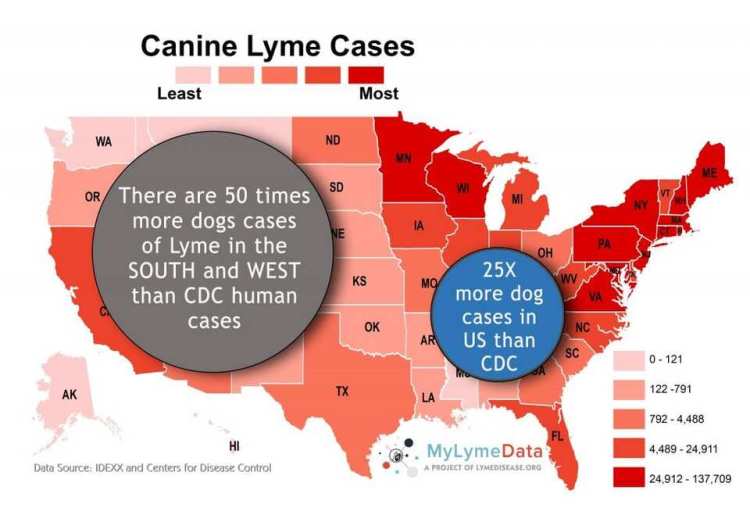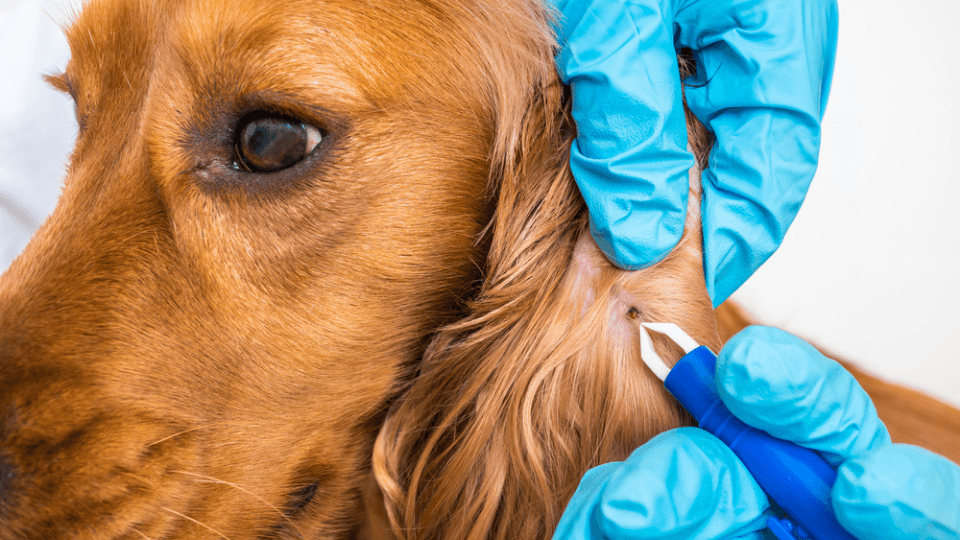Lyme disease is a fairly common infection that can be transmitted by ticks. Also known as Lyme borreliosis, this disease is caused by the Borrelia burgdorferi bacterium that lives on ticks. When a tick bites an animal or person the bacterium can enter the bloodstream, and it can cause issues in specific organs, as well as overall illness. Lyme disease can be difficult to detect and can result in serious, ongoing health issues.
Pro Tip: Dog insurance does cover Lyme disease treatment costs if your pet is enrolled before an infection. Pet health insurance does not cover pre-existing conditions, so it’s important to enroll before any issues arise.
Who Is at Risk of Lyme Disease?
Dogs, people, and less commonly cats, cattle, and horses are at risk of developing Lyme disease. Ticks are commonly found in grassy, sandy, and wooded areas, so it is quite difficult to avoid them. In order to transmit the disease, the tick usually needs to be attached to the animal for 24 - 48 hours.
Lyme disease has been registered in every US state but the risk of infection varies. In fact, most of the cases (more than 95%) are from the Pacific coast, the Upper Midwest, and the Northeast. However, recently, the disease has become increasingly prevalent in regions once thought to be low-risk, including states like Iowa, Illinois, Ohio, North Dakota, and Michigan.
Ticks can also carry other less common bacterial diseases affecting dogs, including babesiosis and anaplasmosis. Babesiosis manifests through a number of symptoms including high fever, dark urine, and severe shock. The symptoms of anaplasmosis are often similar to those for Lyme disease. Both diseases are diagnosed through blood tests similar to those used for Lyme disease by a veterinarian.
Symptoms of Lyme Disease in Dogs
As mentioned earlier, Lyme disease is a fairly common illness but the problem is, it doesn’t come with a consistent set of symptoms.
In people, the disease leaves a skin rash in about 80% of the affected individuals, along with flu-like symptoms, fever, and joint pain. Cardiac and neurological symptoms are much less common. All these symptoms usually appear within a few days to weeks after infection.
In dogs, the signs are different and they take somewhat longer to manifest, usually weeks or even months after transmission. Many pets can have Lyme disease and show no signs. Some of the most common signs of Lyme disease in dogs include:
- Fever
- Lethargy
- Fatigue
- Generalized discomfort, pain, or stiffness
- Lameness (intermittent, shifting, or recurring)
- Swelling of joints
- Loss of appetite
- Weight loss
- Depression
- Swollen lymph nodes
- Vomiting
- Bad breath
If left untreated, Lyme disease can lead to damage in the heart, kidneys, and nervous system. In some cases, kidney damage can turn into Lyme nephritis (inflammation of the kidneys), which can be fatal. Labrador Retrievers and Golden Retrievers are inclined to developing Lyme nephritis, so these breeds should be given extra attention. Serious neurological and cardiac symptoms can also occur.
 Image source: Lyme Disease Organization
Image source: Lyme Disease Organization
How Is Lyme Disease Transmitted?
Lyme disease is transmitted exclusively through tick bites. This means that it cannot be transmitted from dogs to humans, or from one animal to another. However, there’s always a risk that a carrier tick could enter your home on your pup’s fur and get on family members or other pets. Dogs, cats, humans, and wildlife can all serve as carriers unknowingly allowing ticks to hitch a ride and move from outdoor locations into homes where the tick now has access to other humans or pets in the house.
If your four-legged companion is positive for Lyme disease, you and any other animals that have been in the same indoor or outdoor space might be at risk as well. If that’s the case, speak to your doctor to find out if any tests are necessary.
Lyme Disease Diagnosis
Your veterinarian will diagnose the disease based on physical symptoms and health history. Two blood tests are used to diagnose Lyme disease in dogs:
- C6 test, which is used to detect antibodies against the C6 antigen. The presence of antibodies means that the animal is infected with Lyme disease. These antibodies can be detected 3 to 5 weeks after the pup is bitten by an infected tick and might be found in the system even before the animal shows symptoms of the disease.
- Quant C6 test, which along with urine analysis helps to determine whether there is a need for antibiotic treatment.
Treating Lyme Disease in Dogs
If you notice your furry companion has any of the above-listed symptoms, make sure to schedule an appointment with your veterinarian as soon as possible. The veterinarian will conduct a blood test and, if the results come back positive, they will prescribe antibiotics to help get rid of the bacteria from the pup’s bloodstream.
At the moment, Doxycycline and Amoxicillin are the most common treatment choices. After initiating antibiotic therapy, the symptoms will typically subside quickly (usually within 48 hours). Make sure to follow the vet’s instructions when it comes to administering any drugs to your furry companion with regards to timing of the doses, quantity of medication given, and number of days to give the medication. It is crucial to finish administering all of the prescribed courses of antibiotics, even if your dog seems better after a few days. If you stop giving the drugs part way through a course, not all of the bacteria in your dog’s body may be killed, and the remaining bacteria can become resistant to the antibiotic and make your pet sick again.
Pets who test positive for Lyme disease will need to undergo a urine test every year as long-term exposure could lead to renal disease.
Treatment Costs
Lyme disease treatment can be really expensive. You will need to pay the veterinary examination fee, which ranges from $40 - $100, depending on your location. In addition, blood tests usually run about $80. Antibiotics should also be taken into consideration - in some areas, a 14-day supply of these medications can cost about $400 or even more. In worse cases, if the animal needs chronic condition treatment and hospitalization, the bills can get even higher.
How can these costs be reduced?
Getting pet insurance for your dog prior to any illness will protect you from the high costs of treating your pet’s Lyme disease or any other potential emergency, injury, or illness you and your pup might encounter throughout their life. Most pet insurance companies will cover blood tests, treatment, medications, and potentially vet exam fees as long as you chose a plan for your furry friend before they were diagnosed with Lyme disease
 Image source: Arlington Animal Hospital
Image source: Arlington Animal Hospital
Lyme Disease Prevention
If you’re wondering how to prevent Lyme disease, making sure you prevent your dog from getting tick bites is the best way to make sure your pup doesn’t get infected. Here are some tips that can help you prevent ticks from hitching a ride or feeding on your dog in the first place:
- When you go for a walk with your four-legged companion, avoid bushy areas, areas of tall grass, as well as thickly-wooded settings. Stick to marked trails, especially in Lyme-endemic locations.
- Inspect yourself and your pup after taking walks through grassy areas or woods. When checking your furry companion, pay special attention to its lips, ears, eyes, under the tail, groin area, feet, armpits and between the toes. Ticks can be very small (the size of a pinhead) when they’re young, so it might be a good idea to use a flashlight.
- If you do find a tick, make sure to remove it right away using a pair of tweezers. Avoid partially removing or crushing it as bacteria can enter the skin through an open cut or wound. If you are not able to successfully remove the tick, consult with your vet.
- Ask your vet to check your dog for ticks at each exam. If you’ve missed any, the vet will do a thorough exam to best find them.
Preventing ticks altogether can be a difficult task without the assistance of tick control medications. Luckily, there are several over-the-counter tick control products available on the market that work great at repelling ticks from your dog and killing any that might jump on before they can make your dog sick. Some of these include Advantix, Revolution, Frontline, and Preventic collar. Although these may not always prevent attachment or kill the ticks immediately, they will cause a tick to detach before the critical 48-hour timeframe. Consult your vet to decide which product will work for your pup. Many pet insurance plans that include wellness care will even reimburse you for up to 90% of the cost of providing your dog with year round flea and tick preventatives like these.
You should also consider getting your furry companion vaccinated. Vaccination against the bacteria that lead to Lyme disease is possible and recommendable for most dogs living in Lyme-endemic areas especially if they spend a lot of time outdoors in wooded areas. Vaccinating your dog against Lyme Disease bacteria is a great topic to discuss with your veterinarian at your next wellness visit!
Main Takeaways
- Lyme disease is a serious (and sometimes even fatal) infection caused by tick bites that can affect both dogs and humans.
- Dogs are at risk of developing the disease when they spend time outdoors in heavily wooded, tick endemic areas.
- Antibiotics are used to kill the bacteria that cause Lyme disease and can be given after diagnosis by your veterinarian.
- Tick preventatives are recommended year round and vaccines are available to prevent Lyme disease.
- Most pet insurance plans cover Lyme disease treatment so long as it is not a pre-existing condition so getting your dog on a pet insurance plan is most beneficial to you and your pup if you do so while they are healthy.
